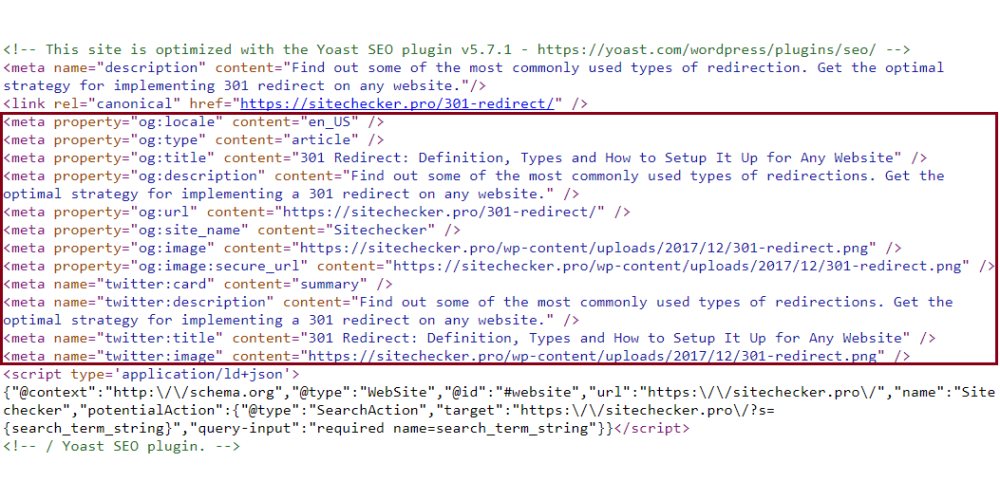The Open Graph Protocol

Introduction
The Open Graph protocol enables any web page to become a rich object in a social graph. For instance, this is used on Facebook to allow any web page to have the same functionality as any other object on Facebook.
While many different technologies and schemas exist and could be combined together, there isn't a single technology which provides enough information to richly represent any web page within the social graph. The Open Graph protocol builds on these existing technologies and gives developers one thing to implement. Developer simplicity is a key goal of the Open Graph protocol which has informed many of the technical design decisions.
Basic Metadata
To turn your web pages into graph objects, you need to add basic metadata to your page. We've based the initial version of the protocol on RDFa which means that you'll place additional <meta> tags in the <head> of your web page. The four required properties for every page are:
og:title- The title of your object as it should appear within the graph, e.g., "The Rock".og:type- The type of your object, e.g., "video.movie". Depending on the type you specify, other properties may also be required.og:image- An image URL which should represent your object within the graph.og:url- The canonical URL of your object that will be used as its permanent ID in the graph, e.g., "http://www.imdb.com/title/tt0117500/".
As an example, the following is the Open Graph protocol markup for The Rock on IMDB:
<html prefix="og: http://ogp.me/ns#">
<head>
<title>The Rock (1996)</title>
<meta property="og:title" content="The Rock" />
<meta property="og:type" content="video.movie" />
<meta property="og:url" content="http://www.imdb.com/title/tt0117500/" />
<meta property="og:image" content="http://ia.media-imdb.com/images/rock.jpg" />
...
</head>
...
</html>
Optional Metadata
The following properties are optional for any object and are generally recommended:
og:audio- A URL to an audio file to accompany this object.og:description- A one to two sentence description of your object.og:determiner- The word that appears before this object's title in a sentence. An enum of (a, an, the, "", auto). Ifautois chosen, the consumer of your data should chose between "a" or "an". Default is "" (blank).og:locale- The locale these tags are marked up in. Of the formatlanguage_TERRITORY. Default isen_US.og:locale:alternate- An array of other locales this page is available in.og:site_name- If your object is part of a larger web site, the name which should be displayed for the overall site. e.g., "IMDb".og:video- A URL to a video file that complements this object.
For example (line-break solely for display purposes):
<meta property="og:audio" content="http://example.com/bond/theme.mp3" />
<meta property="og:description"
content="Sean Connery found fame and fortune as the
suave, sophisticated British agent, James Bond." />
<meta property="og:determiner" content="the" />
<meta property="og:locale" content="en_GB" />
<meta property="og:locale:alternate" content="fr_FR" />
<meta property="og:locale:alternate" content="es_ES" />
<meta property="og:site_name" content="IMDb" />
<meta property="og:video" content="http://example.com/bond/trailer.swf" />The RDF schema (in Turtle) can be found at ogp.me/ns.
Structured Properties
Some properties can have extra metadata attached to them. These are specified in the same way as other metadata with property and content, but the property will have extra :.
The og:image property has some optional structured properties:
og:image:url- Identical toog:image.og:image:secure_url- An alternate url to use if the webpage requires HTTPS.og:image:type- A MIME type for this image.og:image:width- The number of pixels wide.og:image:height- The number of pixels high.
A full image example:
<meta property="og:image" content="http://example.com/ogp.jpg" />
<meta property="og:image:secure_url" content="https://secure.example.com/ogp.jpg" />
<meta property="og:image:type" content="image/jpeg" />
<meta property="og:image:width" content="400" />
<meta property="og:image:height" content="300" />
The og:video tag has the identical tags as og:image. Here is an example:
<meta property="og:video" content="http://example.com/movie.swf" />
<meta property="og:video:secure_url" content="https://secure.example.com/movie.swf" />
<meta property="og:video:type" content="application/x-shockwave-flash" />
<meta property="og:video:width" content="400" />
<meta property="og:video:height" content="300" />
The og:audio tag only has the first 3 properties available (since size doesn't make sense for sound):
<meta property="og:audio" content="http://example.com/sound.mp3" />
<meta property="og:audio:secure_url" content="https://secure.example.com/sound.mp3" />
<meta property="og:audio:type" content="audio/mpeg" />
Arrays
If a tag can have multiple values, just put multiple versions of the same <meta> tag on your page. The first tag (from top to bottom) is given preference during conflicts.
<meta property="og:image" content="http://example.com/rock.jpg" />
<meta property="og:image" content="http://example.com/rock2.jpg" />
Put structured properties after you declare their root tag. Whenever another root element is parsed, that structured property is considered to be done and another one is started.
For example:
<meta property="og:image" content="http://example.com/rock.jpg" />
<meta property="og:image:width" content="300" />
<meta property="og:image:height" content="300" />
<meta property="og:image" content="http://example.com/rock2.jpg" />
<meta property="og:image" content="http://example.com/rock3.jpg" />
<meta property="og:image:height" content="1000" />
means there are 3 images on this page, the first image is 300x300, the middle one has unspecified dimensions, and the last one is 1000px tall.
Read more material and sites
please update us by comment on more important sites and points to add


